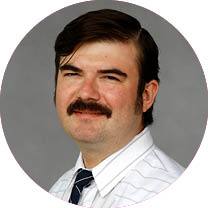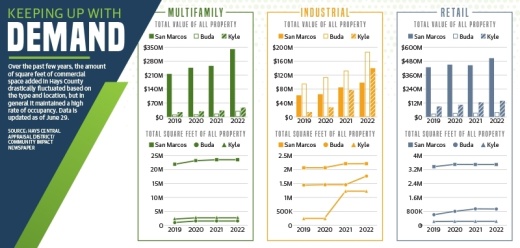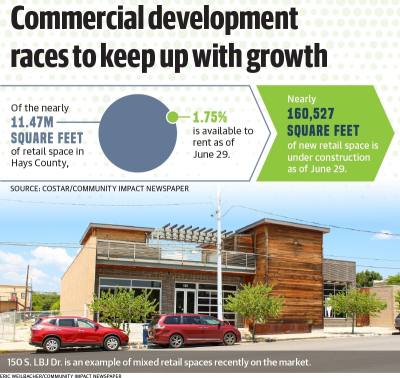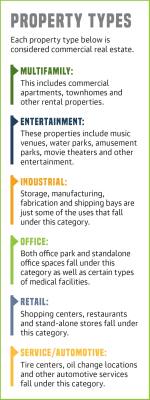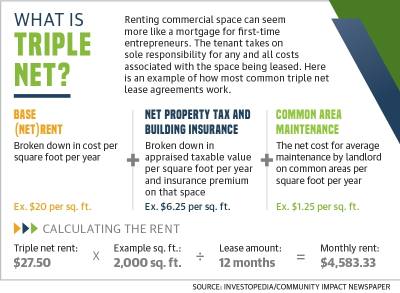At the same time, a very low rate of vacancy in some areas of commercial real estate, such as industrial and retail, is putting pressure on developers to build more in and around the I-35 corridor to bring increased options for businesses.
As of June 29, retail vacancies are 1.75%, and 3.18% of industrial spaces are vacant in Hays County, according to data provided by the CoStar Group, an organization that researches and analyzes the commercial real estate industry. That is out of 11,468,831 square feet of retail space in the county and 13,779,080 square feet of industrial space.
“Major property types are moving in lockstep, showing noticeable increases in rent, absorption and construction. Industrial employment growth is contributing to multifamily demand, which in turn is propelling the need for retail services,” said Israel Linares, senior market analyst for CoStar Group for Central Texas. “I think the best way to kind of describe the dynamics at play in Hays County is that there’s been such a boom in terms of industrial sector employment with logistics and distribution, companies setting up there and more manufacturing,” he said.
Linares said ever-rising prices in real estate in Austin also affect commercial enterprises, and that pushes companies to look further outside the city.
“That paired with sort of the affordability issues of the urban core of Austin has kind of spurred this growth down there. They all kind of are all interplaying at the same time,” he said.
Navigating a hot market
While there is not one singular factor or dataset in determining why a commercial real estate market might be so competitive locally, there are a few things to consider to understand why it is happening. Linares described what he called a “three-pronged expansion” of retail, industrial and multifamily development along the I-35 corridor as the linchpin for further expansion, creating a demand for more people moving to the area as new projects continue with construction and come to fruition.
Jessica Inacio, senior director of business attraction at the Greater San Marcos Partnership, said new commercial spaces in general are filling up as they go up.
“Specifically in the innovation corridor, as we call it, where that pipeline between Austin and San Antonio [is located], we’re seeing more and more come online. ... It’s getting filled up as quickly as it goes up,” Inacio said. “We’re seeing a lot more in speculative space going up, which is really a testament to the market. [There is a] confidence in the market that those tenants will be there when these buildings are getting constructed without a pre-existing client or tenant to fill them.”
Part of the confidence is in the rate of population growth in general, as Hays County continues to see rapid growth. The most recent U.S. Census Bureau data estimates the county has now increased in population by more than 100,000 new residents since 2010.
Inacio said industrial projects began to pop up and continue to expand in the Buda and Kyle areas primarily because of their proximity to the Austin area, but in the past two years, more projects are heading further south to the San Marcos area, as evidenced by Hill Country Studios, an approximately 820,000-square-foot movie and video production studio that Inacio said would be larger than the current largest studio outside of Hollywood, located in Georgia.
Not all of the industrial developments are staying along the I-35 corridor, however.
Inacio said the availability of a growing workforce residing in Hays County juxtaposed with SH 130 just a few minutes away in Caldwell County has created interest in projects there, such as the $1 billion battery and solar power plant facilities Chem-Energy Corp. announced in November in a Chapter 381 agreement with Caldwell County. One plant is slated for Uhland, east of Kyle, and the other near Martindale, just 15 minutes east of San Marcos.
Varying demand among sectors
Not every sector of commercial real estate is steaming ahead in each city at the same rates, however.
Brooke Damron, a broker associate with the Damron Group Realtors, said office and retail particularly in San Marcos is still feeling a fallout from the coronavirus pandemic.
Restaurant space in particular is not moving in certain areas.
“It depends on the space, the finish, the condition, you know, these older sites. They’re typically sitting longer even though they’re going to have lower rent. It’s not all apples to apples, right? So that’s part of the fluctuation when you say it’s all over the map,” Damron said.
Damron pointed to a few successful restaurants that have been for sale and remain in operation that have sat on the market for months or in some cases years, such as Grins Restaurant and Hays County BBQ. Both have also reduced their asking price, she said.
Damron said it is also usually much cheaper to buy an existing business outright than building out much of what is currently available in San Marcos—shell space that would require the business tenant to cover all the costs of building out a kitchen space.
Jeremy Rushing, an associate with the Restaurant Realty Group, a commercial broker that specializes in commercial dining realty in the San Antonio and Austin areas, called the market in San Marcos “weird.” For prospective restaurateurs willing to spend the money on a build-out it will be an investment, he said, anywhere from $100,000 to $1 million. There are options available in the San Marcos market to do so, he said. “It’s dependent on the college, and the businesses field it when it’s not there during the summer or like winter break. It seems like a lot of the Austin [restaurant] groups kind of skip over it and go straight to San Antonio,” Rushing said.
Interest rates create uncertainty
CoStar Group’s findings expect the vacancy rates on office and retail buildings to stay below 4% in the next few years, even with new construction coming online. They report a significant amount of new construction in 2021-22 created a rise in multifamily vacancies this year to under 9%.
Still, some issues in the foreseeable future could dampen the growth on the commercial front.
“I wonder though, given the recent acceleration in interest rates, if that’s going to impact any of these things that have been proposed but haven’t actually broken ground yet—if they’re going to get postponed,” said William Chittenden, professor of finance at Texas State University. “In all three of the reports [from CoStar], they’ve got big spikes in 2023 in terms of what’s supposed to come online.”
Chittenden said recent increases in interest rates by the Federal Reserve will have an immediate effect on homebuyers’ purchasing power, something that could also affect the projected growth of commercial real estate as well. The tension between fast growth in population and the interest rate increases could augment some of the projections for commercial projects, though the outlook is uncertain, he said.
Damron said she, too, wonders what the increase in interest rates will mean for commercial as it is already knocking prospective buyers out of the residential market.
She said she also sees the asking prices for some commercial properties as varying wildly, perhaps as a sign commercial properties are trying to cash in on the ever-rising prices in the residential sector.
“There’s also things on the market right now that I think are way overpriced, and people have gotten caught up in this real estate frenzy that’s definitely happening on the residential side,” she said. “I think that people are trying to ride this residential wave and it’s not translating as much as residential has drastically changed.”


